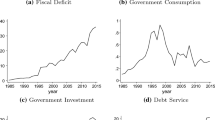Abstract
This paper analyzes local public fiscal andspending behavior in a setting where localgovernments, represented by the dominantparty or coalition, are treated as utilitymaximizing agents. The econometricanalysis, which is based on a modifiedversion of ELES, recognizes total spendingas well as total income as endogenousvariables. Identification of the priceeffects is achieved by utilizing data onenvironmental cost factors and localtastes. The performance of the estimatedmodel is investigated by testing itsability to make out-of-sample predictionsof local government behavior.
Similar content being viewed by others
References
Bahl, R., Johnson, M.B. and Wasylenko, M. (1980). State and local government expenditure determinants: The traditional view and a new approach. In:Bahl, R., Burkhead, J. and Jump, B. Jr., (Eds.), Public employment and state and local government finance. Cambridge, MA: Ballinger.
Bergstrom, T.C. and Goodman, R.P. (1973). Private demands for public goods. American Economic Review 63: 280-296.
Borcherding, T.E. and Deacon, R.T. (1972). The demand for the services of non-federal governments. American Economic Review 62: 891-901.
Borge, L.-E. (1995). Economic and political determinants of fee income in Norwegian local governments. Public Choice 83: 353-373.
Borge, L.-E. and Rattsø, J. (1995). Demographic shift, relative costs and the allocation of local public consumption in Norway. Regional Science and Urban Economics 25: 705-726.
Borge, L.-E., Rattsø, J. and Sørensen, R.J. (1995). Local government service production: The politics of allocative sluggishness. Public Choice 82: 135-157.
Bradford, D., Malt, R. and Oates, W.E. (1969). The rising cost of public services: Some evidence and reflections. National Tax Journal 37: 151-170.
Bradford, D. and Oates, W. (1971). Towards a predictive theory of intergovernmental grants. American Economic Review 61: 440-448.
Ehrenberg, R.G. (1973). The demand for state and local government employees. American Economic Review 63: 366-379.
Gramlich, E.M. (1969). State and local governments and their budget constraint. International Economic Review 10: 163-182.
Gramlich, E.M. and Galper, H. (1973). State and local fiscal behavior and federal grant policy. Brookings Papers on Economic Activity 1: 15-58.
Hines, J.R., Jr. and Thaler, R.H. (1995). The flypaper effect. Journal of Economic Perspectives 9: 217-226.
Howe, H. (1975). Development of the extended linear expenditure system from simple saving assumptions. European Economic Review 6: 305-310.
Inman, R.P. (1971). Towards an econometric model of local budgeting. National Tax Association Papers and Proceedings: 699-719.
Inman, R.P. (1979). The fiscal performance of local governments: An interpretative review. In: Mieszkowski, P. and Straszheim, M. (Eds.), Current issues in urban economics. Baltimore: The John Hopkins University Press.
Johnson, M.B. (1979). Community income, intergovernmental grants, and local school district fiscal behavior. In: Mieszkowski, P. and Oakland, W.H. (Eds.), Fiscal federalism and grants in aid. Washington: The Urban Institute.
Kramer, J. (1973). On a class of equilibrium conditions for majority rule. Econometrica 41: 285-297.
Lluch, C. (1973). The extended linear expenditure system. European Economic Review 4: 21-32.
Lluch, C., Powell, A.A. and Williams, R.A. (1977). Patterns in household demand and saving. Oxford: Oxford University Press.
Pollak, R.A. and Wales, T.J. (1978). Estimation of complete demand systems from houshold budget data: The linear and quadratic expenditure systems. American Economic Review 68: 348-359.
Rattsø, J. (1989). Local government allocation of labour and the grant system: An applied model analysis of local government behaviour in Norway. Environment and Planning C: Government and Policy 7: 273-284.
Riker, W. and Ordeshook, P. (1973). An introduction to positive political theory. Englewood Cliffs, N.J.: Prentice-Hall.
Romer, T. and Rosenthal, H. (1979). The elusive median voter. Journal of Public Economics 12: 143-170.
Rosen, S. (1974). Hedonic prices and implicit markets: Product differentiation in pure competition. Journal of Political Economy 82: 34-55.
Schwab, R.M. and Zampelli, E.M. (1987). Disentangling the demand function from the production function for local public services. Journal of Public Economics 33: 245-260.
Tiebout, C. (1956). A pure theory of local expenditures. Journal of Political Economy 84: 416-424.
Wildasin, D.E. (1986). Urban public finance. New York: Harwood Academic Publishers.
Author information
Authors and Affiliations
Rights and permissions
About this article
Cite this article
Aaberge, R., Langørgen, A. Fiscal and Spending Behavior of Local Governments: Identification of Price Effects when Prices are not Observed. Public Choice 117, 125–161 (2003). https://doi.org/10.1023/A:1026140201401
Issue Date:
DOI: https://doi.org/10.1023/A:1026140201401




